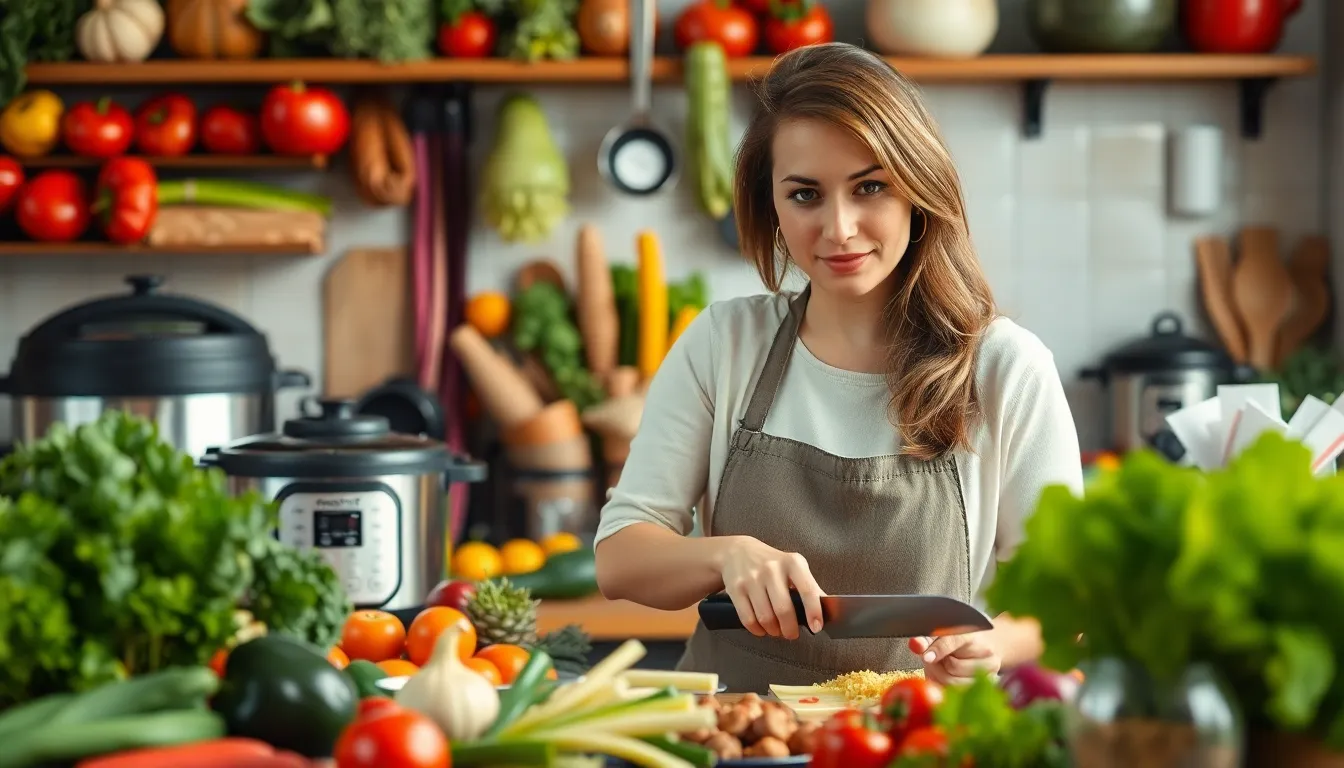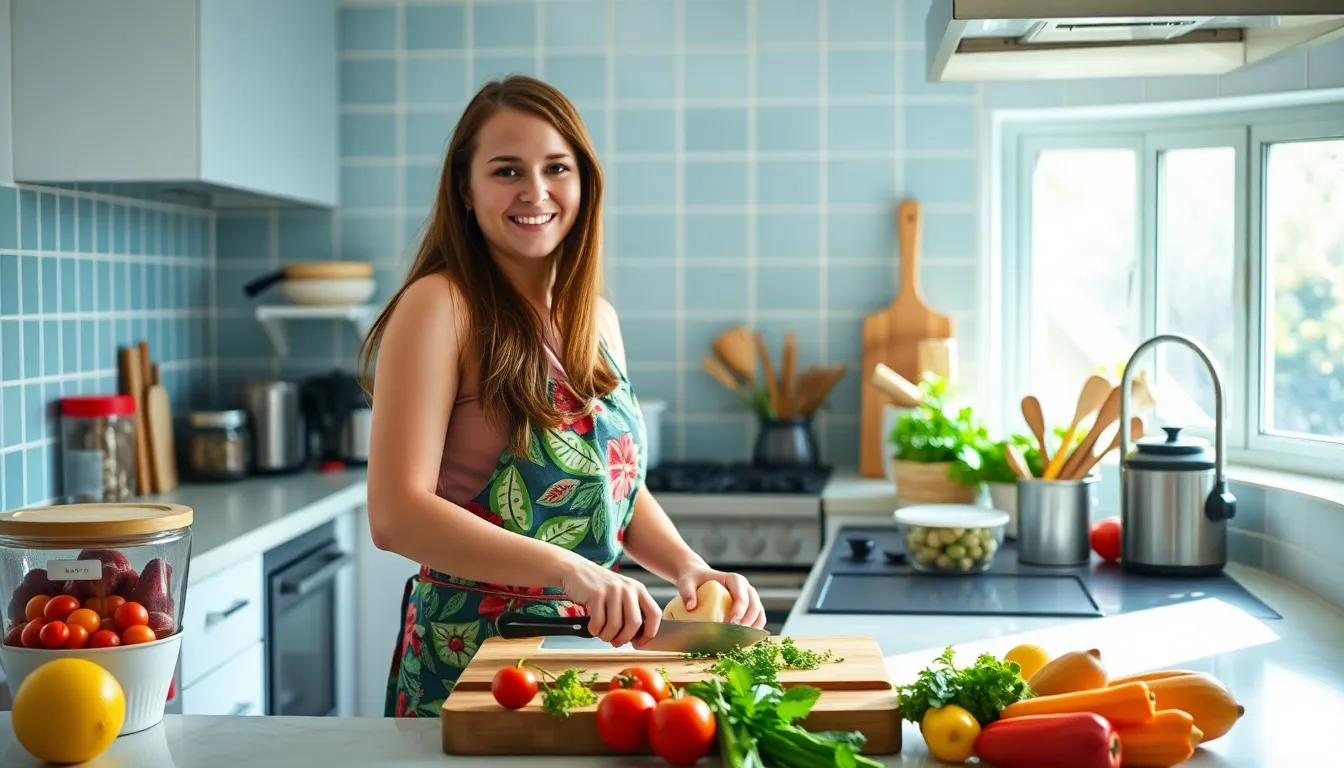In the heart of every home, the kitchen serves as a hub of creativity and nourishment. Yet, it can also become a source of frustration when things don’t go as planned. That’s where handy kitchen tips come in, transforming everyday cooking tasks into smooth and enjoyable experiences.
From clever storage solutions to time-saving techniques, these tips can elevate anyone’s culinary game. Whether she’s a seasoned chef or a novice cook, everyone can benefit from a few insider tricks that make meal prep efficient and fun. With the right strategies, the kitchen can become a place of inspiration rather than chaos.
Table of Contents
ToggleHandy Kitchen Tips for Efficiency
Efficiency in the kitchen enhances creativity and reduces frustration. Implementing organizational strategies and utilizing essential tools streamlines cooking tasks.
Organizing Your Workspace
- Arrange frequently used items within easy reach to minimize movement.
- Organize utensils by category, placing knives, spoons, and spatulas in designated containers.
- Label storage containers for quick identification, ensuring ingredients are accessible when needed.
- Store heavy pots and pans below waist level to reduce strain during cooking.
- Utilize drawer dividers to keep cutlery organized, preventing clutter.
- Incorporate magnetic strips or racks for easy access to spice jars, freeing up counter space.
Essential Tools and Gadgets
- Invest in a high-quality chef’s knife, as it simplifies chopping and dicing tasks significantly.
- Use a cutting board with measurement markings; it aids in accurate portioning.
- Select a multi-functional peeler for versatile kitchen tasks, from peeling vegetables to segmenting fruits.
- Keep a digital kitchen scale on hand for precise ingredient measurements.
- Employ silicone baking mats; they reduce the need for greasing trays while ensuring even baking.
- Consider a food processor to expedite tasks like chopping, shredding, and puréeing.
- Use a slow cooker for hassle-free meals; it allows for ingredient assembly without constant monitoring.
Cooking Techniques to Simplify Tasks

Effective cooking techniques reduce preparation time and enhance the overall cooking experience. Following these strategies can make meal preparation quicker and less stressful.
Quick Meal Prep Ideas
- Batch Cooking: Cook multiple portions of a recipe at once. Store extras in the freezer for quick reheating.
- Chop Ahead: Chop vegetables in advance and store them in airtight containers. This saves time during cooking.
- One-Pan Meals: Opt for recipes that use a single pan. This minimizes cooking time and reduces cleanup.
- Mise en Place: Gather and prepare all ingredients before beginning to cook. This leads to a smoother cooking process.
- Utilize Leftovers: Transform leftovers into new dishes. This not only saves food but also quickens meal prep.
Time-Saving Cooking Methods
- Pressure Cooking: Use a pressure cooker to significantly cut down cooking time for dishes like stews and rice.
- Microwave Cooking: Opt for microwave-safe containers to cook or reheat foods quickly, allowing for faster meal preparation.
- Slow Cooking: Prepare ingredients in a slow cooker. Set it in the morning, and enjoy a ready meal in the evening with minimal effort.
- Stovetop Searing: Sear meats on high heat for quick browning, sealing in flavor without extensive cooking time.
- Freezing Techniques: Freeze pre-marinated proteins or sauces in portions. Thawing requires minimal time, leading to quick dinners.
Cleaning and Maintenance Tips
Maintaining a clean and organized kitchen defines a functional cooking space. Implementing effective cleaning and maintenance practices prolongs the life of tools and enhances overall efficiency.
Keeping Your Tools in Top Shape
- Wash immediately: Clean pots, pans, and utensils right after use to prevent food residue buildup.
- Oil wooden utensils: Regularly apply food-safe mineral oil to wooden cutting boards and spoons to prevent cracking and extend their lifespan.
- Sharpen knives: Sharpen kitchen knives every few months to ensure safe and efficient cutting.
- Store properly: Store knives in a magnetic strip or in a knife block to prevent dulling and accidents.
- Sanitize sponges: Soak sponges in a vinegar solution or microwave them for one minute to eliminate bacteria weekly.
- Tackle stains quickly: Address spills on surfaces and countertops immediately to avoid staining and build-up.
Best Practices for Kitchen Organization
- Utilize drawer dividers: Use adjustable dividers to categorize utensils and make it easier to find necessary tools.
- Label containers: Clearly label storage containers for easy identification of contents and minimize search time.
- Keep frequently used items accessible: Store commonly used pots, pans, and ingredients in easily reachable locations to streamline cooking.
- Group similar items: Organize similar items together, such as baking supplies and frying tools, to enhance workflow during cooking.
- Use vertical space: Install shelves or hanging racks to make use of vertical space, creating additional storage for pots, pans, and herbs.
- Purge regularly: Declutter kitchen items periodically by removing those that are rarely used, ensuring an organization that facilitates a smooth cooking experience.
Tips for Ingredient Management
Effective ingredient management enhances cooking efficiency and helps minimize waste. Here are some key tips for managing ingredients effectively.
Storing Fresh Produce
Storing fresh produce properly maintains quality and extends shelf life.
- Refrigerate Certain Fruits and Vegetables: Keep potatoes, onions, and garlic in a cool, dry place, while refrigerating berries, leafy greens, and apples.
- Utilize Produce Bags: Store produce in breathable bags to reduce moisture and prolong freshness.
- Group Similar Items: Organize fruits next to each other and vegetables together to prevent ethylene gas from causing spoilage.
- Check Regularly for Rotting: Inspect stored produce weekly, removing any spoiled items to prevent them from affecting others.
Using Leftovers Creatively
Using leftovers creatively reduces food waste and allows for quick meal preparation.
- Transform into New Dishes: Turn leftover roasted chicken into a hearty soup or stir-fry for a quick second meal.
- Combine Ingredients: Mix leftover grains with vegetables and dressing for an easy salad.
- Freezing Portions: Freeze unused portions in airtight containers for future use, extending the meal options.
- Repurpose Common Ingredients: Use leftover vegetables in omelets, frittatas, or as toppings on pizzas, adding flavor and nutrients.
Implementing these tips ensures effective ingredient management, streamlining cooking tasks and enhancing the culinary experience.
Embracing handy kitchen tips can truly elevate the cooking experience. By fostering an organized and efficient environment, anyone can unleash their culinary creativity while minimizing stress. Simple strategies like proper ingredient management and effective cleaning routines can transform a kitchen into a harmonious space.
Investing in essential tools not only enhances efficiency but also inspires confidence in the kitchen. With these practical tips, meal preparation becomes less daunting and more enjoyable. Ultimately, a well-structured kitchen encourages experimentation and makes cooking a rewarding journey.





